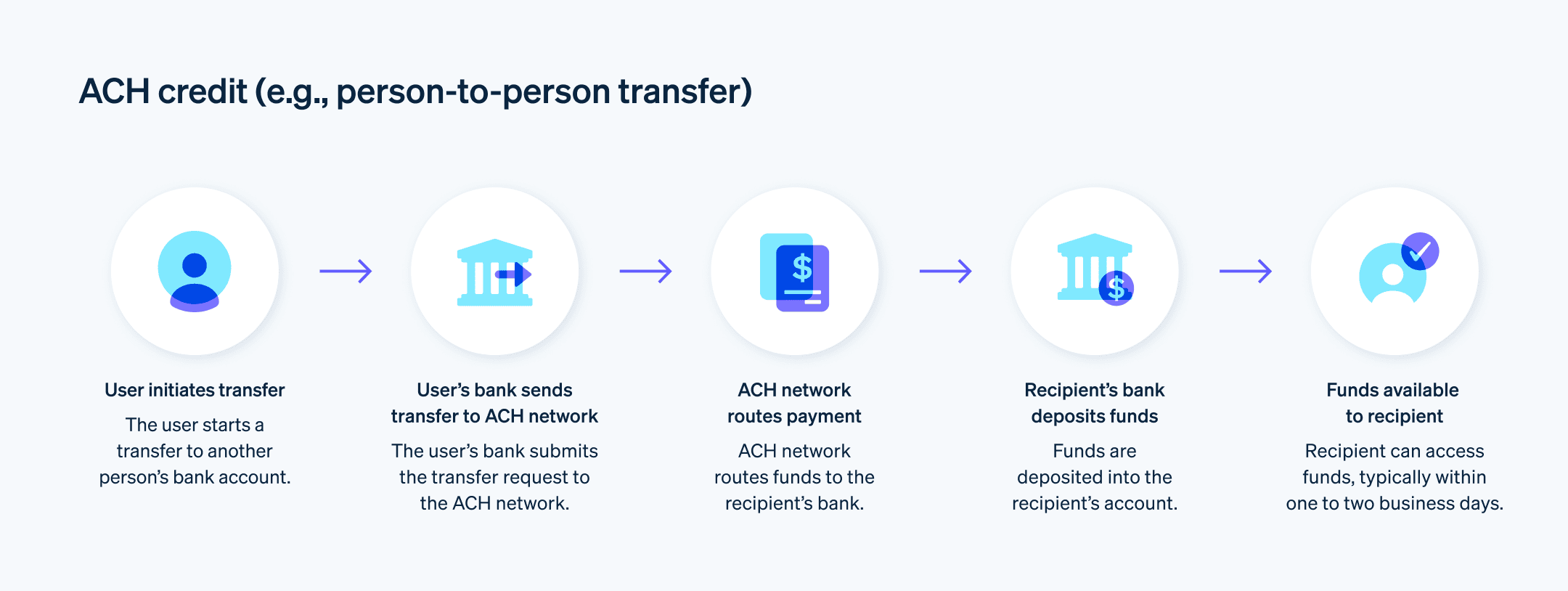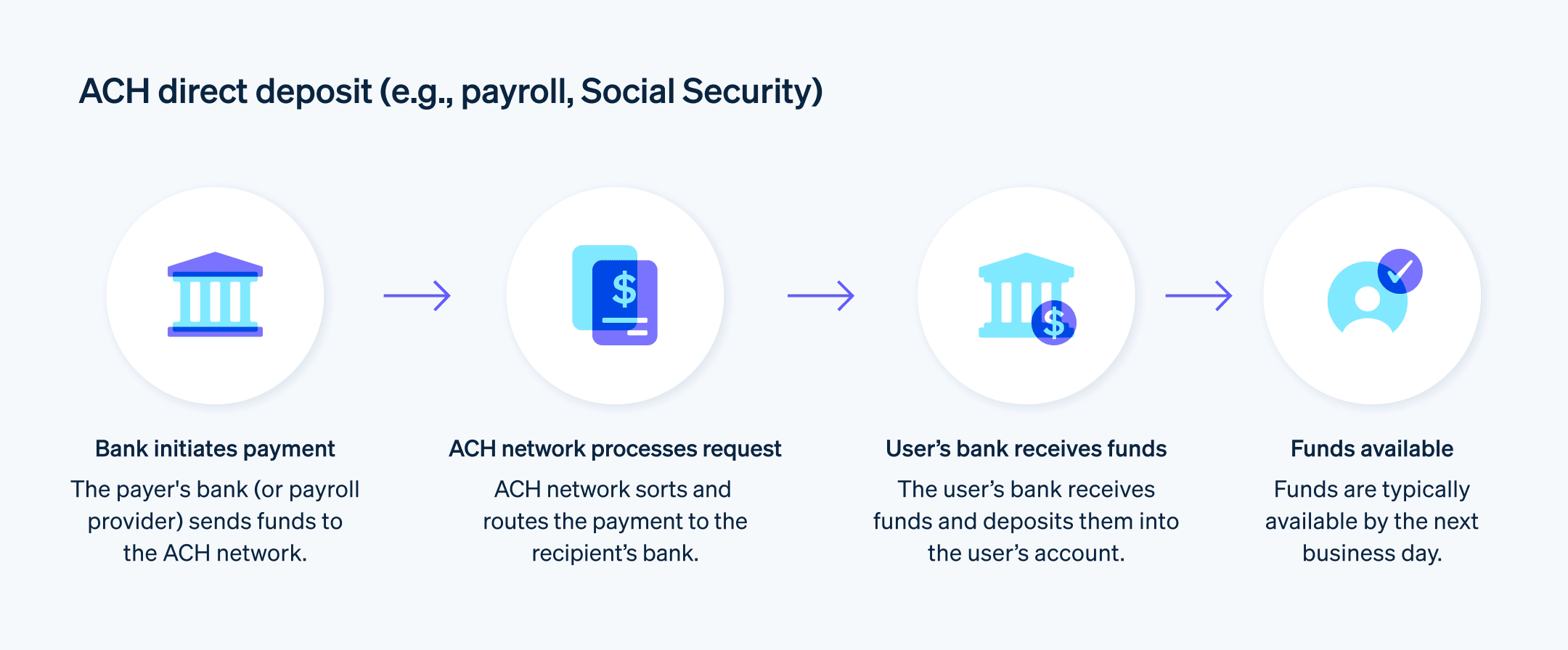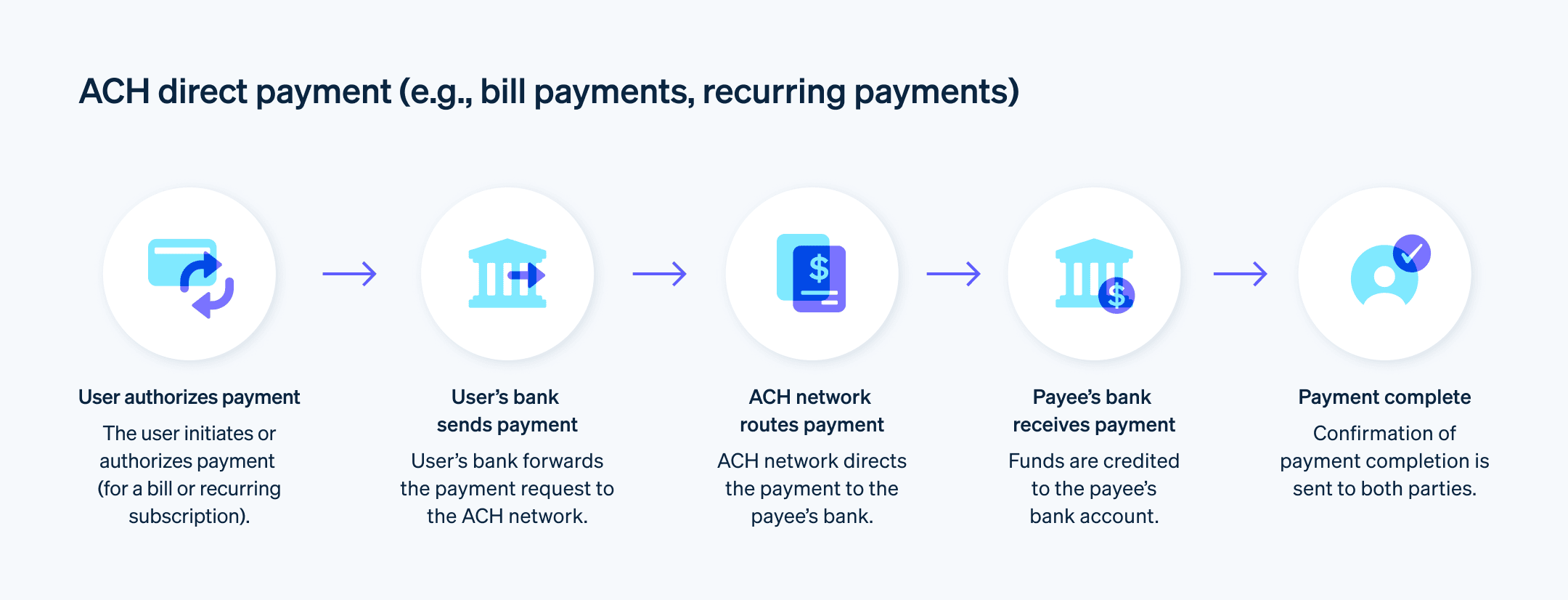Bank transfers are a routine part of our financial lives, but many people understand very little about how they work. When will a transfer arrive? What will it cost? As a consumer, you might not have paid attention to these questions, but as a business owner, it’s important to understand the details of accepting bank transfers as a customer payment method.
So how do bank transfers work for businesses? Let’s outline what you need to know.
What’s in this article?
- What is a bank transfer?
- Types of bank transfers
- Bank debit transfer
- Bank credit transfer
- Bank redirects
- Bank debit transfer
- Types of domestic bank transfers
- ACH transfers
- Wire transfers
- ACH transfers
- International bank transfer networks
- CHAPS
- Bacs
- SEPA
- CHAPS
- What are Bank Identification Codes (BIC)?
- Bank transfer benefits for businesses
- Bank transfer downsides for businesses
- Are bank transfers safe?
- How long do bank transfers take?
What is a bank transfer?
A bank transfer is the electronic movement of funds from one bank account to another. "Bank transfer" is a broad umbrella term, and it includes many different types of transfers and ways to use them.
Types of bank transfers
Bank transfers are categorized based on two factors: where they operate and which network they use to move funds. There are three main types of bank transfers that businesses commonly encounter:
Bank debit transfers
Bank debit transfers occur when an account holder authorizes an outside party to “pull” funds from their bank account. The recipient’s bank initiates the transfer of funds, not the sender’s bank. When a customer sets up this type of bank transfer to make a payment, they provide their name and account details to the recipient, who will then use the account information to pull funds from the sender’s account into their own.
In customer transactions, the customer gives their bank account information to the business’s payment processor, with authorization to withdraw the purchase amount from their account.

Bank credit transfers
These transactions use the same network as debit transfers, but the action is reversed: Instead of the recipient’s account “pulling” money from the sender’s account, credit transfers work by “pushing” money from the sender’s bank account to the recipient’s.

Types of bank transfers
Bank transfers are categorised based on two factors: where they operate and which network they use to move funds. There are three main types of bank transfers that businesses commonly encounter:
Bank debit transfers
Bank debit transfers occur when an account holder authorises an outside party to "pull" funds from their bank account. The recipient's bank initiates the transfer of funds, not the sender's bank. When a customer sets up this type of bank transfer to make a payment, they provide their name and account details to the recipient, who will then use the account information to pull funds from the sender's account into their own.
In customer transactions, the customer gives their bank account information to the business's payment processor, with authorisation to withdraw the purchase amount from their account.
Bank credit transfers
These transactions use the same network as debit transfers, but the action is reversed: Instead of the recipient's account "pulling" money from the sender's account, credit transfers work by "pushing" money from the sender's bank account to the recipient's.
Bank redirects
Bank redirects are used in some online payment situations. Customers are redirected from the business's website to their financial institution's website, where they complete the transfer of funds. Bank redirects are often used for domestic purchases in the US, but they're exponentially more popular overseas – in Germany, the Netherlands and Malaysia, bank redirects drive more than half of all e-commerce transactions. Stripe offers a single integration that supports both domestic and international bank redirects, including Sofort and giropay.
Here's how bank redirects work with Stripe's checkout experience:
- Customer selects "bank redirect" as their payment method at checkout.
- Customer selects their bank from the list of available financial institutions.
- Customer is redirected to that bank’s website.
- Customer enters their account credentials to log in to their bank account.
- Customer authenticates their login, usually via SMS or another two-factor security measure.
- Customer authorises the purchase with their bank.
- Payment is completed, and customer is notified.
- Customer is redirected back to the business's website for confirmation that the transaction has been completed.
Types of domestic bank transfers
Bank transfers in the US fall into two categories: ACH transfers and wire transfers. These transfers take place on different networks.
ACH transfers
ACH stands for Automated Clearing House, a network run by the National Automated Clearing House Association (Nacha) that allows banks and other financial institutions to send and receive money. Nacha is an independent organisation owned by a large group of banks, credit unions and payment processing companies.
The ACH network bundles together any ACH transactions that come in within a given time frame (usually four hours or so on business days) and then settles the transactions in batches periodically throughout the day.
ACH transfers are often used in commercial transactions, but they can be used for many other purposes:
- Customer bill payments
- Tax refunds
- Tax payments
- Retirement and investment account contributions
- Charity donations
- University tuition payments
- Funds sent between family and friends
There are two categories of ACH transfers, distinguished by whether funds are coming into or out of your account:
ACH direct deposit
Direct deposits come into your account via the ACH network and include employer payroll deposits. Ninety-three percent of Americans receive direct-deposit pay cheques from their employer, usually sent as ACH direct deposits. Direct-deposit transfers can also be split, with specified amounts routed to different accounts.ACH direct payment
Direct payments are sent out of your account via the ACH network. These payments account for most ACH transfers that aren’t employer payroll deposits. For example, when a customer uses an ACH transfer to pay a business for goods or services, it’s a direct payment.
Wire transfers
Like ACH transfers, wire transfers also transmit funds between banks. While ACH transfers go through the centralised Nacha network, domestic wire transfers take place using networks that the Federal Reserve operates. Unlike ACH transactions, wire transfers are handled in real time and settled individually. This makes them historically faster than ACH transfers, although recently Nacha has pushed through regulatory updates to speed up ACH transfers.
There are two main Federal Reserve-backed wire transfer systems: the Federal Reserve Wire Network (Fedwire) and the Clearing House Interbank Payments System (CHIPS). These systems handle the majority of domestic funds transfers and international transactions using US dollars.
Fedwire
The Fedwire is a real-time settlement system that uses central bank money to electronically transfer funds between businesses, consumers, banks and government agencies. Fedwire transfers are very popular in the US – in March 2022 alone, more than 18 million Fedwire transfers were sent.CHIPS
Each financial market has a clearing house that validates and finalises transactions between buyers and sellers. CHIPS is the clearing house in the US for large bank transfers; the average CHIPS transfer is over $3 million.

- ACH transfer: ACH Direct Payment
Direct payments are sent out of your account via the ACH network. These payments account for most ACH transfers that aren’t employer payroll deposits. For example, when a customer uses an ACH transfer to pay a business for goods or services, it’s a direct payment.

Wire transfers
Like ACH transfers, wire transfers also transmit funds between banks. While ACH transfers go through the centralized Nacha network, domestic wire transfers take place using networks that the Federal Reserve operates. Unlike ACH transactions, wire transfers are handled in real time and settled individually. This makes them historically faster than ACH transfers, although recently Nacha has pushed through regulatory updates to speed up ACH transfers.
There are two main Federal Reserve–backed wire transfer systems: the Federal Reserve Wire Network (Fedwire) and the Clearing House Interbank Payments System (CHIPS). These systems handle the majority of domestic funds transfers and international transactions using US dollars.
Fedwire
The Fedwire is a real-time settlement system that uses central bank money to electronically transfer funds between businesses, consumers, banks, and government agencies. Fedwire transfers are very popular in the US—in March 2022 alone, more than 18 million Fedwire transfers were sent.CHIPS
Each financial market has a clearing house that validates and finalizes transactions between buyers and sellers. CHIPS is the clearing house in the US for large bank transfers; the average CHIPS transfer is over $3 million.
International bank transfer networks
International bank transfers between the US and other countries most often use the SWIFT (Society for Worldwide Interbank Financial Telecommunication) network. SWIFT was founded in 1973 to connect over 11,000 banks and financial institutions in over 200 countries. This network is managed by central banks in G-10 countries, including Belgium, Canada, France, Germany, Italy, Japan, The Netherlands, Sweden, the United Kingdom, the United States and Switzerland.
Outside the US, other countries have their own systems for conducting bank transfers within their borders. Here are a few examples:
CHAPS
The Clearing House Automated Payments System (CHAPS) is the UK equivalent of ACH. This network is used in the UK for processing same-day Pound Sterling payments.
Bacs
Bacs is a membership organisation made up of 16 top UK banks. In 2020, there were 4.5 billion direct debit payments made through Bacs and about 2 billion direct credit payments.
SEPA
Single Euro Payments Area (SEPA) is an integrated payments system that allows bank account holders in the EU/EEA and the UK to easily transfer funds between different European banks.
What are Bank Identification Codes (BIC)?
BICs identify a specific bank. International wire transfers and currency exchanges made on the SWIFT network require a SWIFT code, a type of BIC.
Bank transfer benefits for businesses
Here are a few key benefits for businesses that accept bank transfers:
No payment reversals or chargebacks
The biggest benefit of bank transfers is that customers can’t reverse them. Unlike credit card payments, which always carry the risk of chargebacks, bank transfers cannot be called back by the customer once they’re initiated.
If the customer is unsatisfied with their purchase after paying with a bank transfer, they must reach out to the business and request a refund instead. This scenario gives the business the best possible opportunity to solve the issue and possibly avoid a funds reversal. Even if a situation warrants returning the customer’s funds, refunds are preferred over chargebacks; refunds give businesses more control over the funds reversal process.
They’re very secure
Bank transfers tend to be very secure for businesses and their customers, while credit card payments carry a relatively higher risk of fraud.
Stripe customers have additional layers of protection for these types of payments. Stripe provides its customers with a virtual bank account number that their customers submit bank transfer payments to. This virtual account number automates reconciliation and prevents businesses from exposing their real account details to customers.
Customers sometimes prefer bank transfers
It’s generally best practice for businesses to accept as many payment methods as possible. Bank transfers, in particular, are attractive to customers who prefer not to use credit or debit cards for certain purchases. The more payment types that you accept, the more customers you’re likely to convert and retain.
Higher conversion rates in Europe and Asia Pacific
Many customer transactions in Europe and Asia Pacific occur via bank transfer. Accommodating this type of payment will make you more favourable to customers who are used to paying this way.
Bank transfer downsides for businesses
While most businesses find bank transfers to be a reliable, secure, easy way to send and receive payments, they’re not without their drawbacks. Here are a few of the drawbacks of bank transfers:
Recurring payments are often not supported
This lack of support could be burdensome or prohibitive if your business sells subscriptions or otherwise deals with recurring payments.
No control over payment amount
Because customers often initiate the transaction, it’s possible that they could send the wrong amount. There are ways to work around this – for example, Stripe holds customers’ bank transfers and allows businesses to reconcile discrepancies for up to 90 days, in most cases. But you’ll still need to devote extra time and resources to overpayment or underpayment issues when you accept bank transfers from customers.
There’s a chance of incomplete payment
Because the transfer process varies across financial institutions, it’s difficult for businesses to give universal bank transfer instructions to their customers. Customers may think that they’ve completed a payment, when they actually need to contact their bank to complete it.
Stripe’s checkout experience mitigates some of this risk. But businesses will still have some risk of incomplete payment, as accepting a bank transfer means relying on the customer to complete the transaction.
Higher possibility of delays
Bank transfer networks sometimes have processing delays. Depending on the banks involved in the transaction, funds received might be subject to a hold that can last for days. Holds and delays become more likely with international transfers. Bank transfer networks are becoming more dependable and speedier every year, but delays still happen more frequently than they do with credit and debit card payments.
Are bank transfers safe?
Bank transfers are usually a very safe way to accept payment from customers, with less risk for businesses compared to credit card payments. On the customer side, however, there’s a risk of wire transfer fraud.
How long do bank transfers take?
Wherever you’re sending funds to or from, most bank transfers are processed and delivered within a few days. Here’s a closer look at the timing that you can expect from different types of bank transfers, domestically and internationally:
USD bank transfers
On 19 March 2021, Nacha’s operating rules expanded to allow same-day settlement of most ACH transactions. According to Nacha’s rules, USD bank transfers are typically delivered within one to two business days, and ACH debit transfers must be processed and delivered by the next business day. Some banks might hold on to funds delivered via ACH transfer for a few days, but this varies by financial institution.
Wire transfers
Domestic wire transfers are processed in real time and are usually delivered within one business day. But if a wire transfer is initiated late on a Friday, it might not be delivered until the following Monday.
International wire transfers
SWIFT bank transfers between the US and other countries typically take one to five business days to be processed and delivered. This is slower than ACH and wire transfers, due to increased mitigation measures against fraud and money laundering.
The content in this article is for general information and education purposes only and should not be construed as legal or tax advice. Stripe does not warrant or guarantee the accuracy, completeness, adequacy, or currency of the information in the article. You should seek the advice of a competent lawyer or accountant licensed to practise in your jurisdiction for advice on your particular situation.